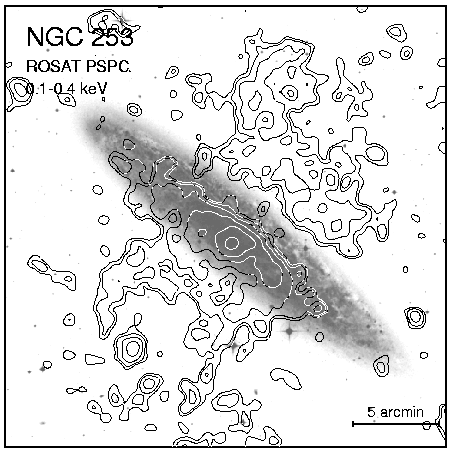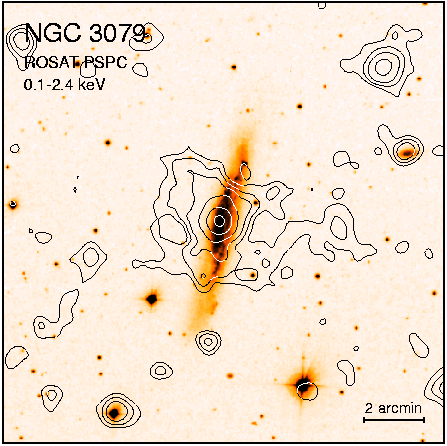

The existence of a very hot component of the interstellar medium in the disk and halo of our Galaxy was predicted by Spitzer in 1956. He proposed typical temperatures of 106-7 K and electron densities of 10-(2-3) cm-3. A quarter of a century later, the Einstein satellite detected X-rays from this hot medium in three spiral galaxies (M 82, NGC 253 and NGC 3628), galaxies with star-formation rates much higher than for `normal type' galaxies. Stellar winds from massive stars together with temporally and spatially correlated supernova explosions can form cavities of hot (million degree) gas in the interstellar medium. These cavities (superbubbles) are usually surrounded by a dense shell of swept-up, cool interstellar medium (supershells). When the supershells `break', hot gas can flow into the halo of the galaxy.
To allow a sensitive search for further examples of hot interstellar media with ROSAT, the `Nearby Galaxies Group' at MPE investigated ten nearby galaxies, nine spirals and one irregular. Different emission components in the individual galaxies have been detected: point-like sources - like active galactic nuclei, X-ray binaries, supernovae (remnants) or superbubbles - and extended diffuse emission from hot interstellar medium distributed in the disk or halo.
All galaxies are visible in the X-ray light [1], seven of them show diffuse emission (NGC 253 [2,3], NGC 1566 [4], NGC 3079 [5], NGC 4258 [6], NGC 4449 [7], NGC 4565 [8] and NGC 4631 [9]). With the exception of NGC 4565, all galaxies with diffuse X-ray emission components are known to show enhanced star formation. For the starburst galaxies NGC 253 and NGC 3079 nuclear superbubbles have been resolved in the X-ray light. In addition, both galaxies show huge X-ray halos. Our figures show the ROSAT PSPC contours superposed onto optical images of NGC 253 and NGC 3079. In the case of NGC 253 the soft band ROSAT observations trace the diffuse emission to much lower surface brightness and temperature compared to the Einstein data. They show a `hole' in the diffuse emission along the north-western rim of the galaxy. This can be explained by the emission of of hot gas filling the halo hemispheres of NGC 253 which is absorbed by cold gas in the disk. The temperatures of the X-ray gas in the halos of NGC 253 and NGC 3079 are around 2×106 K and 4×106 K, respectively.
[1] Vogler A., PhD thesis written at MPE, 1997
[2] Pietsch W., Trümper J., 1993, Adv. Sp. Res. 13, (12) 171
[3] Pietsch et al. 1997, in prep.
[4] Ehle M., Beck R., Haynes R.F., Vogler A., Pietsch W.,
Elmouttie M., Ryder S., 1996, A&A 306, 73
[5] Pietsch W., Trinchieri G., Vogler A., subm. to A&A
[6] Pietsch W., Vogler A., Kahabka P., Jain A., Klein U., 1994,
A&A 284, 386
[7] Vogler A., Pietsch W., 1997, A&A 319, 459
[8] Vogler A., Pietsch W., Kahabka P., 1996, A&A 305, 74
[9] Vogler A., Pietsch W., 1996, A&A 311, 35


Also available as postscript version.